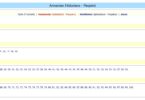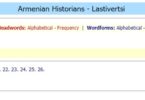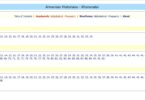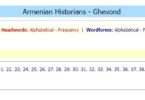ETHNO-HISTORY AND THE ARMENIAN INFLUENCE UPON
THE CAUCASIAN ALBANIANS
Robert H. Hewsen
Glassboro State College (USA)
Caucasian Albanians (pdf version)
It is to be expected at a conference devoted to the reciprocal influences between Armenia and its neighbors that sooner or later our attention should be drawn to the relations between the Armenians and the Caucasian Albanians.[1] Christianized by the Armenians,[2] with a church subordinate to that of Armenia[3], and endowed with an alphabet invented by an Armenian (St. Mesrob Maštoc’),[4] the Albanians acquired several districts of eastern Armenia in the fourth century,[5] and after being largely Islamicized and Turkified in the seventh to twelfth centuries, most of the survivors apparently ended by being absorbed by the Armenians.[6]
If we were merely to restate these facts, however, there would be little need for us to do so here, for they are all well known. What draws our attention to the question of Armeno-Albanian relations is the fact that in recent years these have become the subject of a curious polemic between Azerbaidzhani and Armenian scholars in the Soviet Union. This polemic forces specialists in the West, where objectivity is more easily maintained, to re-examine what we know of these relations, in an attempt to resolve the issues which have been raised.
The controversy in question began in Baku in 1965 with the publication of a monograph entitled “Azerbaidzhan in the Seventh-Ninth Centuries” by the Azerbaidzhani scholar Z. Bunjatov.[7] Space does not permit a detailed analysis of the hypotheses set forth by Bunjatov in this work, but essentially they may be reduced to the following points:
1) The Albanians in antiquity were one of the three major peoples of Caucasia, with a country which extended from Lake Sevan eastwards to the Caspian Sea, and from the Caucasus Range southwards to the River Arax.
2) The influence of the Albanian Church upon its people was gradually reduced by the Armenian Church, which fostered a deliberate polity of Armenicization upon it.[8]
3) The Albanians had a rich national literature which the Armenian clergy, with the connivance and cooperation of the Arabs, translated into its own tongue and then destroyed.[9]
4) The Azeri population of present-day Azerbaidzhan represents in large part the Islamicized and Turkified Albanians. The Armenian population of Azerbaidzhan similarly represents not the Armenian people per se but only the Christianized and Armenicized Albanians.[10]
5) The Armenian population of the mountainous regions of Aran (Siwnik’, Arc’ax, Xač’en, Šak’ē, Gardman, etc.) and elsewhere in Soviet Azerbaidzhan, as well as that of certain villages in the rajons (Russian: ‘district’) of Sisian, Basargeč’ar and elsewhere in Soviet Armenia, shows itself, by its customs and manners, to be identical to the Azeri population of Azerbaidzhan and hence must represent the descendants of Albanians belonging to the Armenian Church, who became assimilated to the Armenians.[11]
Stripped of its academic trappings, what Bunjatov is obviously implying is that the Armenian and Azerbaidzhani populations in both Karabagh and Azerbaidzhan proper are essentially one and the same people except for such details as language and religion. Since the Soviets openly speak of the coming together of the languages of the peoples of the U. S. S. R. (their “mutual enrichment” being the euphemism) and the Soviet attitude toward religion is well known, it is easy to see that neither of these factors would be regarded as being an insurmountable obstacle to the assimilation of peoples in such disputed areas as Karabagh. But beyond this easy equating of two such otherwise distinct ethnic entities as Karabaghi Armenians and Azeri Turks, Bunjatov’s hypotheses have weightier implications. What he appears to be saying is that not only is Karabagh properly Azerbaidzhani territory but much of eastern Soviet Armenia too, if all were allowed their claim.
As bold, aggressive, and pregnant with implications as Bunjatov’s hypotheses obviously are, it was only natural that Armenian academicians should have quickly geared themselves for a campaign in the scholarly journals as their ancestors had once done for battle in the field. The office of Armenian Commander-in-Chief and paramount strategist in this strange war of words was assumed by A. S. Mnac’akanyan, who in less than a year launched a counterattack against the Azeri invasion in the form of a little book with the disingenuous title On Questions of Albanian Literature,[12] a work speedily translated into Russian doubtless to increase its impact.[13] In this study, Mnac’akanyan rebuts the hypotheses of his Azeri antagonist along the following lines:
1) Quoting Strabo (11.4.6; 8.4), Pliny (6.15.4; 16.2), and Ptolemy (5.11), as well as P’awstos Buzand (5.13), Movsēs Xorenac’i (2.44-45), Stephan of Byzantium, and the anonymous Ašxarhac’oyc’, Mnac’akanyan demonstrates that prior to the end of the fourth century A. D. the Albanians inhabited only the regions lying between East Georgia and the Caspian Sea and between the Caucasus Mountains and the River Kur.[14]
2) The regions lying south of the Kur between Lake Sevan and the Arax , i. e. the old Armenian lands of Arc’ax and Utik’, belonged, he claims, to the Armenians from the earliest formation of the Armenian people, i. e. from the seventh century B. C. Taken from the Armenians by the Medes in the sixth century B. C., these lands were reunited with Armenia by King Arta§l!s in the second century B. C.[15]
3) Eastern Armenia, according to Movsēs Xorenac’i (1.12), formed the hereditary domains of the Princes of Siwnik’, a house of Armenian origin.[16]
4) These eastern regions were lost to Armenia and passed under Albanian rule only in 387 A. D. Mnac’akanyan refers to this lost territory as “New Albania” to distinguish it from Albania proper, lying north of the Kur.[17]
5) “New Albania” asserts Mnac’akanyan, was an Armenian entity in every way. Far from being assimilated by their Albanian rulers, the local Armenians reasserted their Armenian nationality, and being culturally more advanced than the Albanian tribes, who had no single language in common, they ultimately absorbed them.[18]
6) All conflicts in regard to Albanian history, ethnicity, language, literature, etc., must be examined, and can only be understood, in the light of the existence of this dual Albania, i. e. Albania proper, north of the Kur, and New Albania, comprised of Armenian territories lying south of that river.[19]
7) The Albanian kings, being Arsacids like the kings of Armenia, were pro-Armenian themselves, and the pro-Armenian element constituted the most advanced stratum of the Albanian population. For this reason Armenian soon became the official language of both the Albanian state and the Albanian church.[20]
8) St. Mesrob provided for the use of the Armenian alphabet among the Armenian population of “New Albania”; his Albanian script was devised only for the use of the Albanians of Albania proper.[21] The scriptures which he presented to the Albanian King Arsuł and to Eremia, the Chief Bishop of Albania, could only have been the already existing Armenian translation. This shows both the high degree of Armenicization of the Albanians at this time, as well as the Armenian orientation of the Albanian church and court.[22]
9) What has been called “Albanian” literature is really only the literature of the Armenians of “New Albania.” This is why, as might be expected, all that has survived of it is written in Armenian. The seventh-century elegy for King Juanšer by the poet Davt’ak, for example, was written in Armenian, as was the History of Albania, by Movsēs Dasxuranc’i, and the numerous so-called “Albanian” documents which it contains.[23]
10) The government of “New Albania” became increasingly Armenian in orientation and the suppression of the Arsacid monarchy of Albania by the Persians in c. 510 A. D. was intended to arrest this process.[24]
11) The Arabs included “New Albania” in the jurisdiction which they called al-Armīniya and referred to the local princes in New Albania as “Armenians”.[25]
12) Finally, apart from the fact that the so-called “Albanian” lands south of the Kur were originally and always Armenian, the Armenians possessed certain territories north of the river as well.[26] The district of Kambečan in original Albania, for example, is called Armenian by Strabo,[27] while the anonymous Ašxarhac’oyc’ describes the Albanian River Seboj as flowing past the Albanian capital Kabala (Arm. Kabałak) across “Lesser Armenia”.[28] Plutarch, moreover, after describing Pompey’s campaigns in Albania in the first century B. C., tells us that he wintered in “Lesser Armenia,” a decision involving a march which is incomprehensible if we are to assume that the Lesser Armenia lying west of the Euphrates is intended.[29]
In short, what Mnac’akanyan seems to assert is that Azerbaidzhan between the Kur and the Arax is, and always has been, ethically Armenian, and, if all parties have their own, the Armenians could justifiably lay claim even to Azerbaidzhani territory north of the Kur.
Mnac’akanyan’s counterattack is a valiant one and, on the surface of it, rather successful. So enthusiastic was the Soviet scholar H. S. Anassian about his colleague’s work that he wrote an article on it for the Revue des études arméniennes in which he endorses Mnac’akanyan’s book with unqualified praise.[30] Upon closer inspection, however, we find that despite his point-by-point rebuttal of Bunjatov’s argument and the numerous novel and imaginative evidence he offers in support of his own, Mnac’akanyan is almost as reckless with his own forces when it comes to overstating his case, misusing his sources, and setting forth as facts what are only suppositions unsupported by the texts which he quotes.
It is not my purpose here to take issue directly with any of the points raised by Bunjatov or Mnac’akanyan. Rather, I would like to confine myself to the role of a third investigator entering the same thickets but unencumbered by the same concern as to the implications of my findings.
Let us take as a starting point the question of the ethnic composition of the population of Arc’ax and Utik’, the regions between the Arax and the Kur which were Armenian territory until 387 and which lie in Azerbaidzhan today. To Mnac’akanyan, this territory was originally Armenian; to Bunjatov, it was Albanian. What do we actually know of its history? Our earliest information is to be found in the History of Herodotus. According to this author, the proto-Armenians were migrants who entered the Armenian plateau from Phrygia in the West, i. e. from Anatolia.[31] The general consensus today is that the Armenians, as we know them, represent a fusion between these incoming tribes-conventionally called “Armens”-and the diverse natives of the plateau who had previously formed a part of the Urartian federation.[32] For this fusion to have taken place, however, the so-called “Armens” would have had to have spread across the plateau from west to east and, though we know little of the circumstances attending this migration, we do catch glimpses of it taking place. Herodotus, writing ca. 450 B. C., makes it clear that in his time the Armenians inhabited only the western third of the plateau, and that to the east of them lay pre-Armenian peoples-Saspeirians and Alarodians.[33] -who had previously formed components of the Urartian state. Xenophon, who travelled through Armenia in the winter of 401-400 B. C., confirms the data of Herodotus, for when he entered the territory of the Phasians and Taokhians, in what was later called north-central Armenia, it is clear that he had left the Armenians behind.[34]
After the fall of the Persian Empire to Alexander in 330 B. C., the Orontids, who had been the Achaemenian governors of Armenia, were allowed to keep control of their province,[35] but, by the time they assumed the royal title in ca. 190 B. C., we find them residing at Armavir in the Ararat plain.[36]
Obviously, the fall of the Persian Empire had provided an opportunity for continued Armenian expansion towards the east, so that in the century between Xenophon’s journey and the establishment of the Orontid monarchy, the Armenians, under Orontid leadership, must have secured control over the central Armenian plateau.
From Strabo we learn that under King Artašēs (188-ca. 161 B. C.), the Armenians expanded in all directions at the expense of their neighbors. Specifically, we are told that at this time they acquired Caspiane and “Phaunitis,” the second of which can only be a copyist’s error for Saunitis, i.e. the principality of Siwnik’.[37] Thus, it was only under Artašēs, in the second century B. C., that the Armenians conquered Siwnik’ and Caspiane and, obviously, the lands of Arc’ax and Utik’, which lay between them. These lands, we are told, were taken from the Medes. Mnac’akanyan’s notion that these lands were already Armenian and were re-conquered by the Armenians at this time thus rests on no evidence at all and indeed contradicts what little we do know of Armenian expansion to the east. Since these eastern regions had formed part of the Persian province of Media before the time of Alexander, it seems likely that if they were seized by the Armenians from the Medes a century or so later, then they had probably remained a part of Media throughout that time. To attempt to demonstrate that these eastern territories were always Armenian by quoting Movsēs Xorenac’i, as Mnac’akanyan does, is hazardous in the extreme. Whoever the enigmatic Xorenac’i may have been, whenever he may have lived, and however valuable his compilation of antiquities may be as the received tradition of the Armenian people, it has been amply demonstrated that his historical knowledge is highly defective even for the most recent periods with which he deals, and that as a source for early Armenian history his book must be used only with the greatest care.[38] The same is true for the other texts which Mnac’akanyan marshals to his cause; all are late and none of them can be used as sources for the extent of Armenian penetration to the east or the boundaries between Armenia and Albania prior to the time of Artašes, let alone the time of Alexander. As for the Armenian origin of the House of Siwnik’ asserted by Movsēs, this is highly dubious, and we have evidence of Siwnian separateness and ethnic particularlism as late as the sixth century A. D.[39]
What do we know of the native population of these regions-Arc’ax and Utik’-prior to the Armenian conquest? Unfortunately, not very much. Greek, Roman, and Armenian authors together provide us with the names of several peoples living there, however–Utians, in Otene,[40] Mycians,[41] Capians,[42] Gargarians,[43] Sakasenians,[44] Gelians,[45] Sodians,[46] Lupenians,[47] Balas[ak]anians,[48] Parsians,[49] Parrasians,[50] -and these names are sufficient to tell us that, whatever their origin, they were certainly not Armenian. Moreover, although certain Iranian peoples must have settled here during the long period of Persian and Median rule, most of the natives were not even Indo-Europeans. Thus, the Utians and Mycians appear to have been migrants from the south, the Yutiya and Maka of Achaemenian times, who at one time had lived in southeastern Iran.[51] The Caspians, on the other hand (if indeed they gave their name to the sea and not the other way around) were probably related to the proto-Georgians,[52] while the Gargarians and the people of Gardman are almost certainly Georgian peoples as we11.[53] The Sakasenians of the region, we know, were surely a Scythian enclave;[54] the Gelians, Sodians, Lupenians and Balasanians were possibly Caucasian tribes;[55] the Parsians and Parrasians alone were probably Iranian. These peoples, all conquered by the Armenians in the second century B. C., must have been subjected to a great deal of Armenicization over the next few centuries, but most of them were still being cited as distinct ethnic entities when these regions passed to Albania in 387, some 500 years later.[56]
But what do we know of the Albanians? According to Strabo, they were originally a group of twenty-six tribes, each with its own king and language , who, sometime before the first century B. C., had federated and had come to be ruled by a single king.[57] From what little we know of the Albanian language, these tribes must have been largely of autochthonous Caucasian origin,[58] but we cannot be certain that this was true of all twenty-six of them. Thus, properly speaking, there was no Albanian people per se but only a federation of Caucasian tribes among whom the Albanians were possibly only one, paramount, tribe which had organized the federation to begin with.
From all of this it appears that the population of southeast Caucasia, whether under Armenian or Albanian rule, was highly mixed, and to label it as being essentially one or the other or even to divide it simply into two groups is well in advance of the evidence.
In 387 A. D., the various peoples of Arc’ax and Utik’, whether Armenians, Armenicized aborigines, or both, passed under Albanian rule[59], which, under these conditions, would have meant that to the various ethnic elements comprising the Albanians north of the Kur a number of others was added to the south. That these peoples were highly Armenicized and that many were actually Armenians per se cannot be doubted.[60] That the Albanians north of the Kur were Armenicized to any great degree seems less certain.[61] That the so-called “Christian” or “New” Albanian culture, which flourished after the transfer of the capital from Kabala, north of the Kur, to Partav, south of the river, in the fifth century, A. D., was essentially Armenian is also beyond question, and here the arguments of Mnac’akanyan are strongest. No trace of an Albanian literature in the Albanian language has survived, and all of the so-called “Albanian” literature which has come down to us is certainly written in Armenian.[62] Contrary to Bunjatov, there is no evidence that any of this literature was translated into Armenian from another language[63] and his assertion that the Armenian Church caused the Albanian literature to be translated into Armenian and then had the originals destroyed is a flight of fancy. As for Mnac’akanyan’s statements concerning Armenian settlement north of the Kur, all we can say at present is that from the evidence at hand it does seem likely that the Armenians at one time possessed the district of Kambečan, possibly granted to them by the Romans to serve as a wedge between Albania and the East Georgian kingdom of Iberia. There is no evidence, however, that Armenians settled in this “Lesser Armenia” in any great numbers in early times or that it ever became ethnically Armenian. The modern Armenian population of nearby Šak’ē and Nuxa probably derives from the dislocations caused by the Turko-Mongolian invasions of the eleventh to thirteenth centuries.
In sum, then, Bunjatov errs in assuming that the basic population of Azerbaidzhan and eastern Armenia is descended from the Caucasian Albanians. He ignores the ethnic complexity of the Albanian Federation north of the Kur as well as that of the Armenian regions south of the river, and he is remarkably cavalier in regard to the extent and impact of Turkish immigration, which was sufficiently large to extinguish almost every other ethnic group in Azerbaidzhan and which must have brought about a major change in the ethnic composition of its lowlands.
Mnac’akanyan, on the other hand, oversimplifies as well. He is certainly wrong in claiming that the lands between the Kur and the Arax were “originally” Armenian, and he, too, underestimates both the ethnic complexity of the region in question and how late the aborigines must have survived as distinct peoples, whether under Armenian or Albanian rule. As far as we can tell, then, the population of southeastern Caucasia, whether north of the River Kur or south of it, consisted of a great variety of peoples: Caucasian mountaineers (Including Albanians), proto-Georgian elements, Scythian enclaves, Iranian, Armenian, and Arab settlers, other miscellaneous interlopers (including some Hungarians)[64] and, above all, a veritable flood of Turkic tribesmen. Ultimately the Christian elements in this heterogenous mass must have been assimilated to the Armenians (and, in part, the Georgians),[65] while the Islamic population was absorbed by the Azeri Turks.
The underlying substrata, however, were originally much too diversified to enable us to agree with either Bunjatov or Mnac’akanyan that the present-day population represents a common ethnic entity, either Albanian or Armenian. Although the present population doubtless contains many true Armenians and many pure Turks, it also comprises many more elements neither Armenian nor Turkish, however totally Armenicized or Turkified they now may be.
On July 7, 1923, Karabagh, the mountainous core of far eastern Armenia, inhabited almost exclusively by Armenians,[66] was declared an autonomous oblast’ within the Azerbaidzhani S.S.R., and so it has remained until the present day. Whether this is just or unjust need not detain us here, for this is a political question rather than an academic one and will doubtless be resolved, if it ever is, on the basis of political considerations. It will not be settled by scholars rummaging about in the fragments of data which have come down to us on the ethno-history of southeastern Caucasia two millennia ago. While scholars certainly have an important and useful role to play in political affairs, Bunjatov and Mnac’akanyan, both excellent scholars, have both erred in placing scholarship at the service of political concerns, which is another matter altogether, and we are reminded, once again, that when such tendentiousness enters the historical arena, scholarship quickly departs.
Published by Scholars Press
CLASSICAL ARMENIAN CULTURE
Influences and Creativity
Proceedings of the First Dr. H. Markarian Conference on Armenian Culture
Edited by Thomas J. Samuelian 1982
University of Pennsylvania Armenian Texts and Studies
[1] Caucasian Albania (Russian Kavkazkaja Albanija) is the term now conventionally used for classical Albania by both Soviet and Western scholars to distinguish it from the modern Albania in the Balkans with which it has no connection. The French Aghovanie based on Armenian Ałuank’ (Aghouank’) is a monstrosity which has fortunately failed to gain currency. The native name for the country is unknown to us.
[2] P’awstos Buzand, Patmut’iwn Hayoc’ (Venice, 1933), French trans. J. B. Emin in M. F. Brosset’s Collection des historiens anciens et modernes de l’Arménie (Paris, 1880), 1, 201-310; Movses Xorenac’i, Patmut’iwn Hayoc’ (Tiflis, 1913), English trans. R. W. Thomson, Mosēs Khorenats’i History of the Armenians (Cambridge, Mass., 1978), 3.3; Movses Kałankatuac’i or Dasxuranc’i, Patmut’iwn Ałuanic’ Ašxarh (Tiflis, 1912), English trans. C. F. J. Dowsett, Movsēs Dasxuranc’i, The History of the Caucasian Albanians (London, 1961), 1.4.
[3] Movsēs Dasxuranc’i 3.8; M. Ormanian, The Church of Armenia (London, 1912; revised ed. London, 1955), 117.
[4] Koriwn, ed. N. Akinean (Vienna, 1952), English trans. B. Norehad, Koriun, the Life of Mashtots (New York, 1964).
[5] P’awstos Buzand 6.1; Ašxarhac’oyc’ (ed. Soukey; Venice, 1881), 39.28-29.
[6] C. Toumanoff, Studies in Christian Caucasian History (Washington, 1963), 58.
[7] Z. Bunjatov, Azerbaidžan v VII-IX vv (Baku, 1965).
[8] Ibid., 97.
[9] Ibid.
[10] Ibid., 100.
[11] Ibid.
[12] A. S. Mnac’a kanyan, Ałuanic’ ašxarhi grakanut’yan harc’eri šurjě (Erevan, 1966).
[13] Mnac ‘a kanyan, O literature kavkazkoj Albanii (Erevan, 1969). I have used this Russian version in preparing this paper.
[14] Mnac’akanyan, Literatura, 18-29.
[15] Ibid., 19.
[16] Actually, all Movsēs Xorenac’i asserts is that the House of Siwnik’ was of Haykid origin which, as Toumanoff has shown (Studies, 108, 216, 218, 222, 469), should be taken as meaning only that it was of immemorial origin; i.e. that it had been sovereign in Siwnik’ for so long that no one remembered its origin.
[17] P’awstos Buzand 6.1 describes these losses in a genera l way but the Ašxarhac’oyc’ makes it clear that the lands which seceded were in fact the same as those which first fell away in the 360’s (P’awstos Buzand 4.50) and recover ed temporarily through the efforts of Mušeł Mamikonian a few years later (P’awstos Buzand 5.8-9, and especially 5.12-13).
[18] Mnac’akanyan, Literatura, 37-44.
[19] Ibid.
[20] Ibid., 51-52.
[21] Ibid., 68-72.
[22] Ibid.
[23] Ibid., 127.
[24] Ibid., 90-102.
[25] Ibid., 59-62.
[26] Ibid., 37-44, 48, 59, 64, 67, 85, 178, 192.
[27] Ibid., 38-41.
[28] Ašxarhac’oyc’, 29, where the edit or inserts a question mark.
[29] P1utarch, Lives (Pompey) LCL, 36.2.
[30] H. S. Anassian, “Mise au point relative à l’Albanie caucasienne,” REArm 6 (1969), 299-330.
[31] Herodotus, LCL 7.73.
[32] Toumanoff, Studies, 52-67.
[33] Herodotus, 3.93-94.
[34] Xenophon, Anabasis LCL, 4.6.5-6.
[35] Toumanoff, Studies, 288-289.
[36] Ibid., 283, 286.
[37] Strabo, 11.14.5; Adontz, 307, 496 n. 72.
[38] R. Thomson, Moses Khorenats’i, “Introduction.”
[39] Sebēos, Sebēosi episkoposi i Herakln (ed. Patkanian; St. Petersburg, 1879), 26.
[40] Herodotus 7.8; Strabo 11.7.1; Pliny 6.16.42, 11.7.1, 8.2; Ptolemy 5.12.4.
[41] Herodotus 7.68.
[42] Ibid., 3.93; Strabo 11.8.8.
[43] Strabo 11.5.1; Movsēs Xorenac’i 2.85, 3.54.
[44] Ibid., 11.8.4, 11.14.; Ptolemy 5.13.9 (where the corrupt form Sakapene is found for the district).
[45] Pliny 7.18.48; Strabo 11.7.1, 11.8.1; Ełišē- Patmut’iwn Vardananc’ (Tiflis, 1913), French trans. by V. Langlois in CHAMA 2.178-251.5, p. 116; Sebeos 12-13; Movses Xorenac’i 2.54; Movsēs Dasxuranc’i 2.19.
[46] Ibid., 6.11.29; Ptolemy 5.12.
[47] Ibid., 6.12.30; Agat’angełos, Patmut’iwn Hayoc’ (Tiflis, 1914), ed. and English trans. R. W. Thomson, Agathangelos’ History of the Armenians (Albany, N. Y., 1976), 1.1; Ełišē passim.; Łazar P’arpec’i , Patmut’iwn Hayoc’ (Tiflis, 1907), 30, French trans. by S. Ghesarian in CHAMA, 2.253-368.
[48] Pawstos Buzand 3.7; Koriwn 11.5, 34; Ełišē 6 p. 134; Ašxarhac’oyc’ 33/34.
[49] Strabo 11.7.1
[50] Ibid.; Herodotus (7.68) has the Mycians and the Utians in Southern Iran; E. Herzfeld, The Persian Empire (Wiesbaden, 1968), 300-301, identifies them with the Maka and the Yutiya of the Achaemenian inscriptions.
[51] Herzfeld, Persian Empire, 300-301.
[52] Toumanoff, Studies, 60 n. 58, where through the mutation of the K S root we find the relation Kashkai – Kaspioi – Qulba – Kolkhis – and possibly K’art’li (east Georgia).
[53] Supra n. 52.
[54] Strabo 11.7.1; Adontz, 324, 495 n. 70.
[55] Ibid.
[56] Agat’angełos, 1.1; Ełišē 3.58 (both 5th cent.) cites the Lp’ink’ who are the Lupenii of Pliny (6.11.29) writing half a millennium earlier (cf. also Movsēs Dasxuranc’i 2.2). This people has since disappeared but left its name in that of the Lop’nas River (now the Dzegam or Akstafa?).
[57] Strabo 11.4.6.
[58] A. Shanidze, “Novootkrytyj alfavit kavkazkix Albantsev i ego značenie dlja nauki,” Bulletin de l’Institut Marr 4 (Tbilisi, 1938); G. Dumezil, “Une chrétienté disparue. Les Albaniens du Caucase,” Journal Asiatique 232 (1940-41).
[59] Supra nn. 5, 17.
[60] The overwhelmingly widespread use of the Armenian language as shown in the pages of Movsēs Dasxuranc’i makes this absolutely clear.
[61] The Udi language appears to have been the Caucasian language prevalent north of the Kur until the nineteenth century, and the present Armenian population appears to be of relatively recent arrival. Many undoubtedly settled there fleeing the Turko-Mongolic invasions but many more entered the region with the coming of the Russians in the early nineteenth century. Cf. Don Juan van Halen, Narrative of Don Juan van Halen (London, 1827), II, 343; Hyde Clark, Memoire of the Comparative Grammar of Egyptian Coptic and Ude (London, 1873), 13.
[62] The nearest thing to an “Albanian literature” we possess in the corpus of documents and other antiquities compiled by Movsēs Dasxuranc’i in the tenth century and expanded as late as the eleventh.
[63] The meticulousness of early Armenian translators in their fidelity to the texts which they were rendering into Armenian precluded “loose” renderings into a “smooth” Armenian, and was such that the original language may almost always be detected in the style of the translation.
[64] Pseudo-Vardan, Ašxarhac’oyc’ Vardanay Vardapeti (ed. H. Berberian; Paris, 1960), 34 line 129; J. Markwart, Osteuropaīsche und ostasiatische Streifzuge (Leipzig, 1903) 34-20, 428, 496; Markwart, Skizzen zur historischen Topographie und Geschichte von Kaukasien (Vienna, 1928), 35; J. Laurent, L’Arménie entre Byzance et l’Islam (Paris, 1919), 23-24.
[65] Toumanoff, Studies, 58-59.
[66] In the Soviet census of 1970 the Armenians formed 80.5% of the population of the Nagarno-Karabaxskaja A.O.







